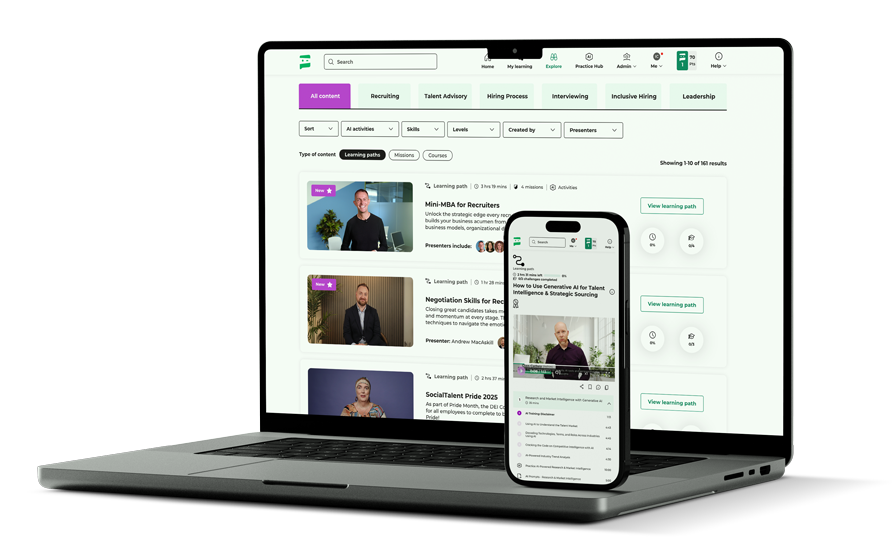
By Johnny Campbell
Why AI in Talent Acquisition Feels Different
Three times in my recruiting career, I’ve seen the industry undergo massive change. First, when job boards emerged in the late ’90s. Then, when social media made sourcing scalable like never before. And now, we’re in the middle of the third wave: the rise of AI in recruiting.
But this shift feels fundamentally different. It’s not just about new technology – it’s about redefining how we work, what recruiters do, and how we create value. It’s exciting. But it’s also chaotic. And for many, it’s also deeply uncertain.
Earlier this week, I hosted a panel with four exceptional talent acquisition leaders to explore how AI is truly transforming recruitment:
- Rachel Allen, Senior Director, Talent Acquisition, 7-Eleven
- October Ambrose, VP, People Partnerships & Engagement, Central Health
- Dhiraj Gupta, Senior Manager Talent Acquisition, Amazon
- Tim Wesson, SVP Talent Acquisition, IQVIA
Each leader was at a different stage in their AI journey – but all shared a human-first mindset. Here are the key takeaways every talent acquisition leader should know.
1. Don’t Start with AI Tools – Start with the Hiring Problems
When 7-Eleven acquired Speedway, Rachel Allen inherited a fragmented hiring system: two tech stacks, competing models, and the sudden loss of 400 recruiters. Her mandate? Deliver faster, scalable store hiring – with a fraction of the resources.
Instead of jumping into AI, Rachel focused on identifying the bottlenecks: missed hires due to slow processes, poor visibility, and lack of accountability at the store level. Once the problems were clear, her team implemented an AI-powered automation platform that now handles 95% of the hiring process.
Results? Time-to-hire dropped from 11 days to under 3. Store managers toggle hiring with a button. They make 120,000 hires annually – and see improved candidate quality.
“I think we don’t give enough credit to understanding the problem you’re trying to solve,” Rachel told me.
Tip: Use AI to solve hiring challenges, not just to adopt technology.
2. Efficiency and Empathy Can Coexist in Hiring
Working in healthcare, October Ambrose sees hiring through a different lens. “I’m not looking for speed,” she said. “I’m really looking for efficiency and relevance.”
While her team explores automation for high-volume roles like medical assistants, provider and specialist roles still require a white-glove approach. And it’s not just about candidates – it’s about patients.
“The North Star is always our patients,” she explained. “It ultimately impacts the quality of care that we provide to patients when we have team members that are engaged.”
Lesson: Automation in recruiting should enhance empathy, not erase it.
3. Win with Micro-AI: Small Automations at Scale
At Amazon, Dhiraj Gupta doesn’t deploy sweeping AI platforms. Instead, his team integrates small AI-driven solutions – like Boolean search assistance, interview debrief summaries, and custom recruiter-built apps – throughout the hiring journey.
Many of these innovations come from recruiters themselves.
“You know the pain points you are facing on a daily basis,” Dhiraj explained. “Why don’t you build the tool and we’ll give you the technology.” The result? A living, breathing ecosystem of micro-innovations that remove friction and increase recruiter productivity.
Takeaway: Make your culture the platform. Empower recruiters to be builders.
4. Build AI Business Cases That Speak to the CFO
Tim Wesson put it plainly: Time savings are meaningless if they don’t show up in the financials.
At IQVIA, where 80% of hiring is client-billable, AI’s value lies in accelerating time-to-bill and lowering cost-per-hire. Revenue and productivity gains make the investment tangible.
Rachel echoed this from the retail perspective: Saving store managers time = more time on the floor = more revenue.
Pro tip: Frame your AI hiring strategy in terms of ROI and business impact.
5. Make Change Management a Priority
Technology doesn’t fail – poor change management does.
At 7-Eleven, Rachel didn’t just launch AI. She built a campaign around it: roadshows, feedback loops, test pilots, store manager buy-in, and a support line staffed by former recruiters.
They even named the AI “Rita” (Recruiting Individuals Through Automation). Store managers were so engaged, some thought she was a real person!
Takeaway: Treat implementation like a marketing campaign. Win hearts before you roll out tools.
6. Address AI Bias Proactively
Let me tell you a quick story. I was demoing a fun AI tool that turns photos into Pixar-style cartoons. I shared a group image with colleagues. My friend Paul, who’s Black, looked at the image and asked, “What’s missing?”
He wasn’t in it. The tool had rendered everyone but him.
Later, it added him – but turned our Asian colleague Black. This is the insidious, unintentional bias AI can carry when the training data isn’t representative. And if it happens in harmless tools, imagine the risk in hiring.
Takeaway: AI decisions are only as fair as the data that feeds them. Trust, but verify. Then verify again.
7. Speed in Recruiting Doesn’t Kill Quality – It Enables It
There’s a common misconception that faster hiring sacrifices quality. Every panelist disagreed.
At 7-Eleven, shorter hiring cycles helped secure stronger candidates. For IQVIA, hiring velocity improved satisfaction for both managers and applicants. At Amazon, automated note summaries led to more proactive and strategic hires.
Bottom line: Delays kill quality. Speed, when smart, enhances it.
Final Thought: AI in Recruiting Is About Being More Human, Not Less
Here’s the big insight I took from this panel: The future of recruiting isn’t AI replacing humans. It’s Humans + AI. And that’s where the real power lies.
AI frees up time for the work that matters most:
- Building stronger candidate relationships
- Understanding what truly makes a great hire
- Customizing experiences that resonate
- Bringing empathy and strategy to the forefront
But it doesn’t happen by accident. You need:
- Real-world hiring problems to solve
- Reliable data and measurable results
- Stakeholder alignment
- Human-centered implementation
- A culture that encourages experimentation
If you’re a TA leader, this is your call to action. The AI era in recruiting isn’t coming – it’s already here. But the winners won’t be the ones who chase every shiny tool. They’ll be the ones who lead with purpose, solve real problems, and scale what makes hiring truly excellent.
This article originally appeared in Johnny Campbell’s Talent Leadership Insights LinkedIn newsletter. Click here to subscribe!




